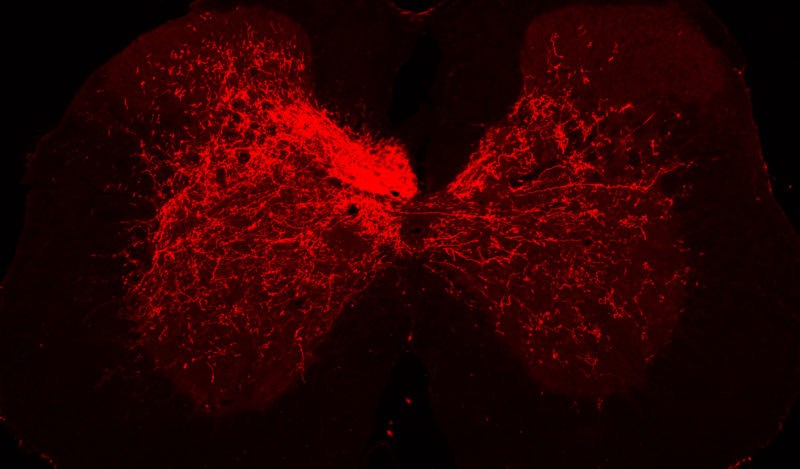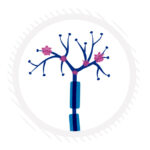Novel therapeutic cocktail could restore fine motor skills after spinal cord injury and stroke

Neuron cells have long finger-like structures, called axons, that extend outward to conduct impulses and transmit information to other neurons and muscle fibers. After spinal cord injury or stroke, axons originating in the brain’s cortex and along the spinal cord become damaged, disrupting motor skills. Now, reported today in Neuron, a team of scientists at Boston Children’s Hospital has developed a method to promote axon regrowth after injury.
“In mice, for the first time, we have a treatment that promotes functional recovery after spinal cord injury and stroke,” says senior author on the paper, Zhigang He, PhD, of Boston Children’s Hospital and Harvard Medical School.
The team developed a therapeutic cocktail which took its roots in previous work. During earlier research into optical nerve injury with Joshua Sanes, PhD, of Harvard University, He’s team had observed that the combination of insulin-like growth factor 1 (IGF1) and a protein called osteopontin (OPN) promoted nerve regrowth and vision improvement in optically-injured mice. He’s team decided to investigate whether this mixture had therapeutic potential in other types of nerves.
Regaining function after spinal cord injury
First, the team studied a mouse model of spinal cord injury to one side of the body. Without intervention after injury, the mice were gradually able to recover some major motor function through natural resprouting of their axons. But, big shortfalls remained in their fine motor skills, making it difficult for them to walk on ladders with irregularly spaced rungs or retrieve food pellets.
In contrast, when the mice were injected with adeno-associated viruses expressing IGF1 and OPN one day after spinal cord injury, their fine motor skills greatly improved. By week 12, the team observed that the mice’s error rates on the irregular ladder dropped to 46 percent, performing strikingly better than the untreated control group, which still continued to make errors 70 percent of the time.
According to He, the improvement was caused by a boost in spinal cord axon sprouting and regeneration that resulted from the therapeutic mixture.
Next, the team wondered if the addition of 4-aminopyridine-3-methanol, known to improve axon conduction, into their therapeutic cocktail would further enhance the mice’s functional recovery.
When they treated the mice with the trio of molecules, they saw their error rates in the irregular ladder task fall to 30 percent, even more narrowly trailing the 20 percent error rate of the uninjured side of the body.

Recovering motor function after stroke
While studying a mouse model of stroke, He’s team made a surprising observation.
“First, we saw what we expected – axon sprouting in spinal cord,” says He. “But then, we also found something unexpected – increased axon sprouting in the subcortical area of the brain.”
The subcortical area is located below the brain’s cortex, and is crucial for many complex motor and non-motor functions.
“The functional outcomes of such subcortical sprouting remain to be tested,” He says.
Excited by their findings, He’s team is now in talks with rehabilitation centers to determine the prerequisites of ultimately taking this work to clinical trials.
Yuanyuan Liu, Xuhua Wang, Wenlei Li contributed equally to this work.
Supporters of the study include grants from Craig Neilsen Foundation, NINDS, Wings for Life, Hong Kong Spinal Cord Injury Fund and Dr. Miriam and Sheldon G. Adelson Medical Research Foundation. IDDRC and viral cores used for this study were supported by NIH grants P30 HD018655 and P30EY012196.
Read more about Zhigang He’s Research
Related Posts :
-

Parsing the promise of inosine for neurogenic bladder
Spinal cord damage — whether from traumatic injury or conditions such as spina bifida — can have a profound impact on bladder ...
-

The thalamus: A potential therapeutic target for neurodevelopmental disorders
Years ago, as a neurology resident, Chinfei Chen, MD, PhD, cared for a 20-year-old woman who had experienced a very ...
-

Could peripheral neuropathy be stopped before it starts?
An increase in high-fat, high-fructose foods in people’s diets has contributed to a dramatic increase in type 2 diabetes. This, ...
-

Mutations during prenatal development may contribute to schizophrenia
Schizophrenia is known to have a genetic component, and variants in 10 genes have been identified as markedly increasing schizophrenia risk. ...





